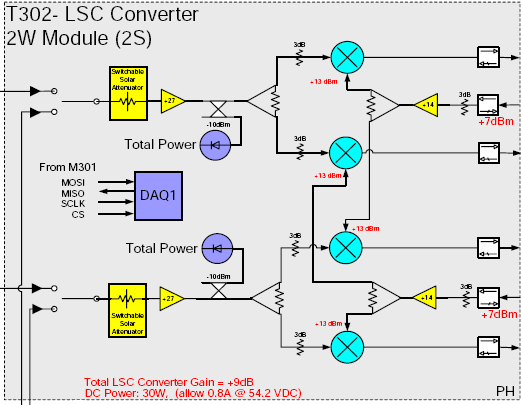| Overview | Package | Class | Use | Tree | Deprecated | Index | Help |

|

|
|||||||||
| PREV CLASS NEXT CLASS | FRAMES NO FRAMES | |||||||||
| SUMMARY: NESTED | FIELD | CONSTR | METHOD | DETAIL: FIELD | CONSTR | METHOD | |||||||||
java.lang.Objectedu.nrao.sss.model.resource.evla.T302
public class T302
The EVLA T302 LSC Upconverter.
This device has two halves that are identical. Each half has two inputs, only one of which may be selected (by an internal switch) at a time. The input is split onto two paths, each of which is mixed with a different local oscillator signal and output. The local oscillator deemed "LO1" influences equally one input in the top half and one in the bottom. The same is true for LO2.
As used by the EVLA electronics, the
top inputs carry left circular polarized signals that have come from
either the 4/P converter, or from a switch that outputs either the
L, S, or C band LCP signal. The bottom inputs are similar, except that
they carry RCP signals. Note: the text above is accurate only if the
4/P converter output switches are in there standard positions.
It is possible to feed the 4/P LCP or RCP to both the top and bottom
inputs of this T302.

Version Info:
| $Revision: 1241 $ |
| $Date: 2008-04-25 14:37:37 -0600 (Fri, 25 Apr 2008) $ |
| $Author: dharland $ (last person to modify) |
| Constructor Summary | |
|---|---|
T302(SignalSource LO1,
SignalSource LO2)
Creates a new T302 LSC Upconverter that uses the given sources as its local oscillators. |
|
| Method Summary | |
|---|---|
void |
execute()
See SignalProcessor.execute(). |
void |
executeFromStartOfChainUpTo(SignalProcessor firstUnexecutedDevice)
See SignalProcessor.executeFromStartOfChainUpTo(SignalProcessor). |
void |
executeUpTo(SignalProcessor firstUnexecutedDevice)
See SignalProcessor.executeUpTo(SignalProcessor). |
List<SignalPipe> |
getBottomInputPipes()
Returns the two bottom inputs for this converter. |
SignalPipe |
getBottomLO1Output()
Returns the output that came from one of the bottom inputs and was mixed with the LO-1 signal. |
SignalPipe |
getBottomLO2Output()
Returns the output that came from one of the bottom inputs and was mixed with the LO-2 signal. |
Collection<Signal> |
getSignals()
Returns the signals produced by this converter. |
List<SignalPipe> |
getTopInputPipes()
Returns the two top inputs for this converter. |
SignalPipe |
getTopLO1Output()
Returns the output that came from one of the top inputs and was mixed with the LO-1 signal. |
SignalPipe |
getTopLO2Output()
Returns the output that came from one of the top inputs and was mixed with the LO-2 signal. |
void |
setInputSwitches(String topSwInputPoleName,
String bottomSwInputPoleName)
Sets the input top and bottom input switches to select one of their inputs. |
List<Frequency> |
suggestLOFrequencies()
Suggests frequencies for tuning the local oscillators that were used in the construction of this device. |
| Methods inherited from class java.lang.Object |
|---|
clone, equals, finalize, getClass, hashCode, notify, notifyAll, toString, wait, wait, wait |
| Constructor Detail |
|---|
public T302(SignalSource LO1,
SignalSource LO2)
LO1 - provider of the LO-1 local oscillator signal.LO2 - provider of the LO-2 local oscillator signal.| Method Detail |
|---|
public void setInputSwitches(String topSwInputPoleName,
String bottomSwInputPoleName)
nameInputPolesOfInputSwitches(String, String, String, String).
topSwInputPoleName - the name of an input pole of the top input switch of this converter.bottomSwInputPoleName - the name of an input pole of the bottom input switch of this converter.public List<SignalPipe> getTopInputPipes()
In the EVLA antenna electronics, the top inputs will be used for left circular polarized signals coming from switch S2-2 (input pole 0) and the T301 top output (input pole 1).
public List<SignalPipe> getBottomInputPipes()
In the EVLA antenna electronics, the bottom inputs will be used for rigth circular polarized signals coming from switch S2-1 (input pole 0) and the T301 bottom output (input pole 1).
public SignalPipe getTopLO1Output()
public SignalPipe getTopLO2Output()
public SignalPipe getBottomLO1Output()
public SignalPipe getBottomLO2Output()
public Collection<Signal> getSignals()
public List<Frequency> suggestLOFrequencies()
construction of this device.
The suggested tunings take into account the current input signals being
fed to this converter, as well as a target center for the output signal
of 10.0 GHz.
Note: this method makes some assumptions in its determinations. These assumptions, which may not suit all clients, are as follows:
public void execute()
SignalProcessor.execute().
execute in interface SignalProcessorpublic void executeUpTo(SignalProcessor firstUnexecutedDevice)
SignalProcessor.executeUpTo(SignalProcessor).
executeUpTo in interface SignalProcessorpublic void executeFromStartOfChainUpTo(SignalProcessor firstUnexecutedDevice)
SignalProcessor.executeFromStartOfChainUpTo(SignalProcessor).
executeFromStartOfChainUpTo in interface SignalProcessor
|
|
|||||||||
| PREV CLASS NEXT CLASS | FRAMES NO FRAMES | |||||||||
| SUMMARY: NESTED | FIELD | CONSTR | METHOD | DETAIL: FIELD | CONSTR | METHOD | |||||||||